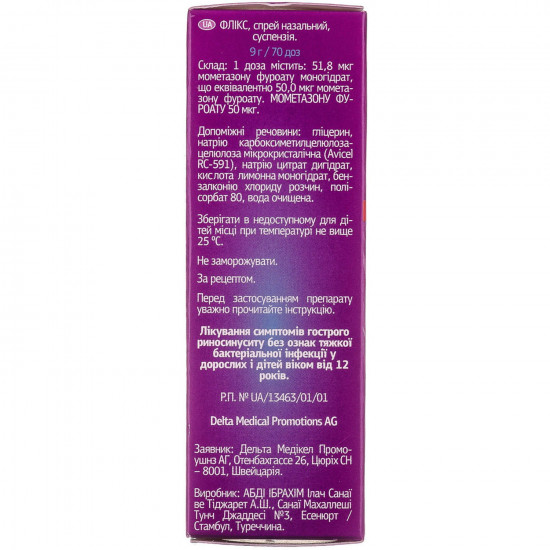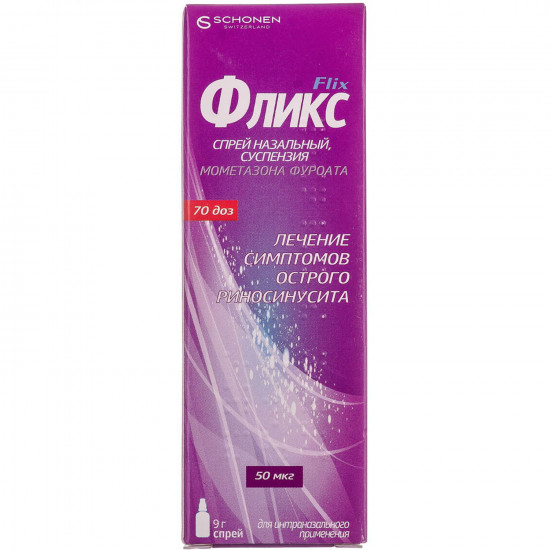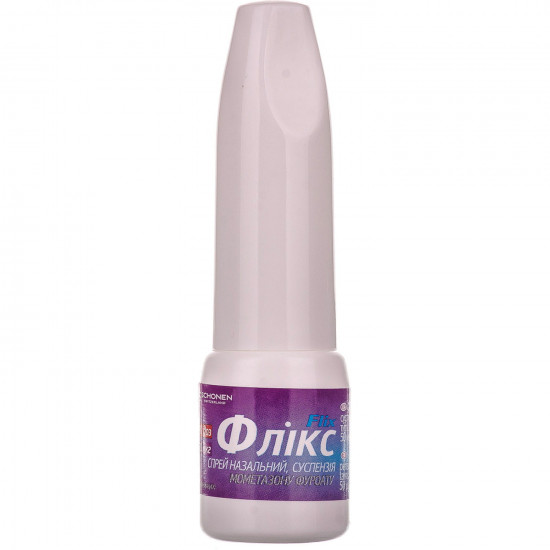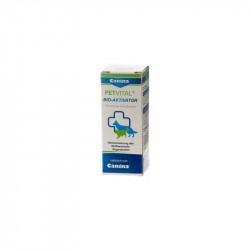







- Stock: In Stock
- Model: 179740
0% Customers recommend this product
-
5 Awesome0%
-
4 Great0%
-
3 Average0%
-
2 Bad0%
-
1 Poor0%
Reviews Over Flix spray nazat., susp. 0.05% fl. 9 g
- (0)
Total Reviews (0)
click here write review to add review for this product.
Report this review.
Description
Pharmacological properties
Pharmacodynamics. the mometazona furoate — synthetic gks for topical administration, has the expressed anti-inflammatory effect. local anti-inflammatory action of a mometazon of furoate is shown in doses at which there are no system effects.
generally the mechanism of anti-inflammatory and antiallergic action of a mometazon of furoate is connected bywith its ability to suppress discharge of mediators of allergic reactions. Mometazona furoate considerably reduces synthesis/release of leukotrienes from leukocytes of patients with allergic diseases. Mometazona furoate showed on the culture of cages by 10 times big activity, than other steroids, including beclomethasone Dipropionas, betamethasone, a hydrocortisone and dexamethasone, on oppression of synthesis/release of interleukin (IL)-1, IL-6 and a factor of necrosis опухоли-α. It is also powerful inhibitor of products Th 2 cytokines, IL-4 and IL-5 from human CD4+ of T-cages. Mometazona furoate is also 6 times more active, than beclomethasone Dipropionas and betamethasone, on inhibition of products of IL-5.
byduring the researches with provocative tests with putting antigens for a mucous membrane of a nose revealed high anti-inflammatory activity of nasal spray of a mometazon furoate both in early, and in a late stage of allergic reaction. It was confirmed with decrease (in comparison with placebo) the level of a histamine and activity of eosinophils and also reduction (in comparison with initial level) numbers of eosinophils, neutrocytes and proteins of adhesion of epithelial cells.
Significant clinical effect in the first 12 h use of nasal spray of a mometazon of furoate was reached byat 28% of patients with seasonal allergic rhinitis. On average (50%) improvement occurred during 35.9 h. Besides, Flix revealed considerable efficiency in weakening of eye symptoms (reddening, dacryagogue, an itch) at patients with seasonal allergic rhinitis.
during clinical trials at patients with nasal polyps of Flix showed toconsiderable clinical performance on elimination of congestion of a nose, reduction of the sizes of polyps, recovery of sense of smell in comparison with placebo.
during clinical trials with participation of patients aged from 12 years use of spray on 200 mkg 2 times a day showed tohigh efficiency on weakening of symptoms of the rinosinusit in comparison with placebo.
Pharmacokinetics. The bioavailability of a mometazon of furoate at application in the form of water-based nasal spray is insignificant (≤0.1%), and it practically does not decide in blood plasma even when using a sensitive method of definition on a threshold of sensitivity of 50 pg/ml. In this regard the relevant pharmacokinetic data for this dosage form do not exist. Suspension of a mometazon of furoate is very poorly absorbed in a GIT, and a small amount which can be swallowed and absorbed is exposed to active primary metabolism even before excretion mainly in the form of metabolites with bile and somewhat — with urine.
Distribution. It was reported that in vitro linking of a mometazon of furoate with blood proteins made 98–99% in the range of concentration of 5-500 ng/ml.
Metabolism. At a research of metabolism of a mometazon of furoate the lack of its main metabolites in blood plasma is proved. In the conditions of in vitro one of minor metabolites — 6β-гидроксимометазона furoate which is metabolized with participation of P450 3A4 is defined (CYP 3A4).
Removal. T ½ makes 5.8 h. The main part of metabolites is removed with bile, the rest — with urine.
Indication
- Treatment in the presence of symptoms of seasonal and year-round allergic rhinitis at adults and children aged from 2 years; preventive treatment of seasonal allergic rhinitis of an average and heavy current at adults and children is aged more senior than 12 years; as supportive therapeutic application at treatment by antibiotics of sharp episodes of sinusitis at adults (including patients of advanced age) and children is aged more senior than 12 years; treatment in the presence of symptoms of the sharp rinosinusit without symptoms of a heavy bacterial infection at adults and children is aged more senior than 12 years; treatment at nasal polyps and the related symptoms, including congestion of a nose and loss of olfactory feelings at patients aged from 18 years.
Use
by
Duration of a course of treatment is determined by the doctor. before each application it is necessary to clean a nose from slime carefully.
Use for treatment and prevention of seasonal or year-round allergic rhinitis at adults and children is aged more senior than 12 years. The adult (including at patients of advanced age) and to children 12 years the recommended preventive and therapeutic dose of medicine are aged more senior makes 2 injections (on 50 mkg everyone) in each nostril of 1 times a day (the general daily dose — 200 mkg). After achievement of medical effect for maintenance therapy it is reasonable to lower a dose to 1 injection in each nostril of 1 times a day (the general daily dose — 100 mkg).
If does not manage to be reached weakening of symptoms of a disease by use of medicine in the recommended therapeutic dose, the daily dose can be raised to maximum: on 4 injections in each nostril of 1 times a day (the general daily dose — 400 mkg). After reduction of expressiveness of symptoms of a disease the dose decline is recommended.
Drug showed toclinically significant beginning of action during 12 h after the first application for some patients with seasonal allergic rhinitis. However the full advantage of treatment cannot be received in the first 48 h therefore the patient needs to continue regular application for achievement of full therapeutic effect.
For children at the age of 2–11 years the recommended therapeutic dose makes 1 injection (50 mkg) in each nostril of 1 times a day (the general daily dose — 100 mkg).
should begin Treatment of patients with the known seasonal allergic rhinitis withwith preventive use of medicine during 2–4 weeks till a blossoming season.
Auxiliary treatment at sharp sinusitis. The adult (including to elderly people) and to children 12 years the recommended therapeutic dose are aged more senior makes 2 injections (on 50 mkg) in each nostril 2 times a day (the general daily dose — 400 mkg).
If does not manage to be reached weakening of symptoms of a disease by use of medicine in the recommended therapeutic dose, the daily dose can be raised to 4 injections in each nostril 2 times a day (the general daily dose — 800 mkg). After easing of expressiveness of symptoms of a disease the dose decline is recommended.
Sharp rinosinusit. To adults and children 12 years the recommended therapeutic dose are aged more senior makes 2 injections (on 50 mkg) in each nostril 2 times a day (the general daily dose — 400 mkg).
Nasal polyps. For patients aged from 18 years (including for elderly people) the recommended dose makes 2 injections (on 50 mkg) in each nostril 2 times a day (the general daily dose — 400 mkg). After achievement of clinical effect it is recommended to lower a dose to 2 injections in each nostril of 1 times a day (the general daily dose — 200 mkg).
Contraindication
Hypersensitivity to one of medicine ingredients. presence of not treated localized infection with damage of a mucous membrane of a nose. recently postponed surgical interventions on a nose or nose injuries before full healing of damage.
Side effects
during clinical trials at seasonal and year-round allergic rhinitises noted such by-effects connected with use of medicine: a headache (8%), nasal bleedings (that is obvious bleeding and also discharge of bloody slime or clots) (8%), pharyngitis (4%), burning sensation in a nose (2%), irritation (2%) and ulcer changes (1%) of a mucous membrane of a nose and also an upper respiratory tract infection. celebrated isolated cases of immediate hypersensitivity. development of the similar undesirable phenomena is typical at use of any nasal spray containing gks. nasal bleedings stopped independently and were moderate, arose a little more often, than at use of placebo (5%), but less than at application of others intranasal gks which were investigated and applied as active control (at application of some of them the frequency of developing of nasal bleedings was up to 15%). frequency of emergence of other undesirable phenomena was comparable to that at use of placebo.
At children the frequency of development of the undesirable phenomena, including nasal bleedings (6%), a headache (3%), feeling of irritation in a nose (2%) and sneezing (2%), was comparable to that at use of placebo (4%).
After intranasal application of a mometazon of furoate the allergic reaction of immediate type (for example a bronchospasm, short wind) can sometimes arise. Very seldom there were an anaphylactic reaction and a Quincke's disease.
toIt was reported about isolated cases of violations of taste and olfactory feelings.
At use of nasal spray as supportive application for treatment at sharp episodes of sinusitis were noted by the undesirable phenomena which frequency of emergence was comparable to that at use of placebo: a headache (2%), pharyngitis (1%), burning sensation in a nose (1%) and irritation of a mucous membrane of a nose (1%). Nasal bleedings were moderate and the frequency of their emergence at use of medicine was also comparable with a frequency of nasal bleedings at use of placebo (5 and 4% respectively).
total number of the above-stated undesirable phenomena was comparableAt patients with nasal polyps, a sharp rinosinusit at use of spray to that at use of placebo and like quantity which was observed at patients with allergic rhinitis.
Very seldom at intranasal application of GKS were noted by cases of perforation of a nasal partition or increase in intraocular pressure.
Special instructions
Use of medicine for children of younger age should be carried out byunder observation and by means of adults.
byWhen carrying out placebo - controlled clinical trials did not note a growth inhibition at children to whom a mometazona furoate applied in a dose 100 mkg within a year.
should not use Drug in the presence of not treated local infection with involvement in process of a mucous membrane of a nose.
Because GKS slow down healing of wounds, it is not necessary to appoint such medicines for topical intranasal administration by the patient which transferred surgery or an injury of a nose, before full healing of wounds recently.
Spray should be applied with care or not to apply absolutely at patients with an active or latent tuberculosis infection of a respiratory path and also at not treated fungal, bacterial, system viral infection or at herpes simplex infection with damage of eyes.
After the 12-month Flix medicament treatment symptoms of a mucosal atrophy of a nose did not arise; besides, a mometazona furoate contributed to normalization of a histologic picture of a mucous membrane of a nose. As well as during any long-term treatment, the patients using medicament within several months and longer have to have periodically examination on identification of possible changes of a mucous membrane of a nose. In case of development of a local fungal infection of a nose or a throat the therapy termination by medicine or performing the corresponding treatment can be required. The irritation of a mucous membrane of a nose and throat which remains for a long time can also be the indication to the treatment termination.
byAt long therapy by the medicine Flix of signs of oppression of function gipotalamo - the hypophysial and adrenal system was not observed. Patients who pass to treatment with nasal spray after long therapy of GKS of systemic action demand attentive observation. The termination of reception of GKS of systemic action at these patients can result in insufficiency of function of bark of adrenal glands that can demand therapy restoration by system GKS and applications of other corresponding treatment.
Upon transition from therapy of GKS of systemic action to treatment by spray some patients along with simplification of nasal symptoms can have symptoms of cancellation of GKS (for example joint and/or muscles pain, feeling of fatigue and a depression). Such patients need to be convinced specially of expediency of continuation of treatment by spray. Change of therapy can also reveal allergic diseases (such as allergic conjunctivitis, eczema, etc.) which developed earlier and masked therapy of GKS of systemic action.
Patients applying GKS can potentially have the lowered immune responsiveness and have to be warned about the increased risk of infection in case of contact with sick some infectious diseases (for example by chicken pox, measles) and also about need of consultation of the doctor if such contact took place.
Should warn patients about need of the immediate address to the doctor in case of signs or symptoms of a heavy bacterial infection, such as fervescence, severe unilateral pain in a face or a toothache, an orbital or periorbital swelling / hypostasis or aggravation of symptoms after initial improvement.
Controlled clinical trials showed that intranasal GKS can slow down growth rate at children. It is necessary to watch the growth rate of the children accepting intranasal GKS. It is necessary to estimate influence of long-term treatment on growth, the received clinical advantage and also safety and efficiency of alternative treatment using nonsteroid medicines. The oppressing influence of medicine on growth should not be ignored at treatment of sensitive patients and at use of medicine in high doses.
Ability to influence speed of response at control of vehicles or other mechanisms. There is no information on influence on ability to steer vehicles and to work with mechanisms.
Use during pregnancy or feeding by a breast. Drug belongs to the category C of use of medicines during pregnancy. Sufficient or well controlled researches with participation of pregnant women were not conducted. Concentration of a mometazon in blood plasma after intranasal introduction of the maximum recommended clinical dose are not defined; thus, influence on fetal fetation, as expected, will be insignificant, and the potential of reproductive toxicity — very low.
byAs well as with other nasal medicines GKS, resolving an issue of use of spray of a mometazon of furoate for pregnant women, it is necessary to compare potential risk for the fruit/baby to the expected advantage.
should not use Drug during pregnancy, except for emergency cases.
Children, given rise by mothers applying GKS during pregnancy it is necessary to survey carefully rather possible hypoadrenalism.
Does not know towhether gets mometazon into breast milk. As it is known that other GKS are allocated with breast milk, it is necessary to show care at use of nasal spray of a mometazon of furoate.
Making the decision on the feeding termination by a breast or medicament treatment, it is necessary to consider advantage of feeding by a breast for the child and treatment of a mometazon furoate for mother.
Children. Do not appoint to children under 2 years. Did not investigate safety and efficiency of medicine at treatment of nasal polyps at children (aged up to 18 years), rinosinusit symptoms — aged up to 12 years, seasonal or year-round allergic rhinitis — at children under 2 years.
byInteraction
At application of a mometazon of furoate in a combination with loratadiny did not observe the expressed influence on concentration of a loratadin and its main metabolite in blood plasma. concentration of a mometazon in blood plasma was not defined. the combined treatment well was transferred by patients.
OverdoseTaking into account low (≤0.1%) system bioavailability of medicine it is improbable
that at overdose other measures, except observation of a condition of the patient with the subsequent use of medicine in the recommended dose will be required. Inhalation or intake of GKS overdoses can lead
to function suppression gipotalamo - a hypophysial and adrenal system.
Storage conditions
At a temperature not above 25 °C. not to freeze.
Specifications
| Characteristics | |
| Active ingredients | Mometazon |
| Amount of active ingredient | 0.05 mg/g |
| Applicant | Schonen |
| Code of automatic telephone exchange | R01AD09 Mometazon |
| Interaction with food | It doesn't matter |
| Light sensitivity | Not sensitive |
| Market status | The branded generic |
| Origin | Chemical |
| Prescription status | According to the prescription |
| Primary packing | bottle |
| Producer | ABDI IBRAHIM ILATSCH SANAI WE TIDZHARET |
| Quantity in packing | 9 g |
| Release form | nasal spray |
| Route of administration | Nasal |
| Sign | Import |
| Storage temperature | from 1 °C to 25 °C |
| Trade name | Flix |















































